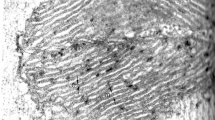Abstract
Rates of turnover and oxidation of plasma free fatty acid (FFA) were determined in unanesthetized dogs during exercise, acute cold exposure and anaphylactic shock, with the aid of a technique involving the continuous infusion of albumin-bound palmitate-1-14C and the simultaneous measurement of O2 uptake, CO2 output and the specific activities of CO2 and FFA. During exercise in normal untrained dogs, plasma FFA supplied 20–30% of the energy, whereas in trained dogs 70–90% of the energy was derived from the FFA oxidation. In resting dogs at room temperature the plasma FFA level was 0.58 μEq/ml with a turnover rate of 18.6 μEq/kg/min of which 22% was immeditely oxidized and contributed 29% to the exhaled CO2. These results were compared with data obtained in pancreatectomized and thyroidectomized dogs. Acute cold exposure (temperature 4–5C) increased the FFA level and turnover rate to 1.02 μEq/ml and 28.0 μEq/kg/min, respectively, of which 33% was immedaitely oxidized, contributing 46% to the exhaled CO2. During anaphylactic shock, blood lactate increased, FFA level and turnover rate were reduced, and the fraction which was immediately oxidized was depressed markedly, i.e., 3–9% of FFA turnover. Sodium lactate infusion, which induces a blood lactate level comparable to that seen in anaphylaxis or nicotinic acid infusion, markedly decreased the level and turnover rate of FFA. However the fraction of turnover oxidized remained the same as during the preinfusion period (range of 21–40%. Exercise or the administration of norepinephrine during anaphylactic shock provided results suggesting that endogenous lactic acid interferes with FFA oxidation, whereas exogenous, lactate had no effect on this oxidation.
Similar content being viewed by others
References
Armstrong, D.T., R. Steele, N. Altszuler, A. Dunn, J.S. Bishop and R.C. De Bodo, Amer. J. Physiol. 201:9 (1961).
Issekutz, B., Jr., H.I. Miller, P. Paul and K. Rodahl, Ibid. 207:583 (1964).
Paul, P., J. Appl. Physiol. 28:127 (1970).
Paul P., in “Advances in Experimental Medicine and Biology,” Vol. 11, Edited by B. Pernow and B. Saltin, Plenum Press, New York, 1971 p. 225.
Fredrickson, C.S., and R. Ono, J. Lab. Clin. Med. 51:147 (1958).
Issekutz, B., Jr., H.I. Miller, P. Paul and K. Rodahl, Amer. J. Physiol. 209:1137 (1965).
Issekutz, B., Jr., P. Paul and H.I. Miller, J. Appl. Physiol. 213:857 (1967).
Steele, R., N. Altszuler, J.S. Wall, A. Dunn and R.C. De Bodo, Amer. J. Physiol. 196:221 (1959).
Paul, P., and B. Issekutz, Jr., J. Appl. Physiol. 22:615 (1967).
Long, C.L., J.L. Spencer, J.M. Kinney and J.W. Geiger, Ibid. 31:110 (1971).
Randle, P.J., and G.H. Smith, Biochem. J. 70:470 (1958).
Drucker, W.R., and J.C. De Kiewiet, Amer. J. Physiol. 206:317 (1964).
Spitzer, J.J., and J.A. Spitzer, Amer. J. Appl. Physiol. 222:101 (1972).
Birke, G., L.A. Carlson and S.-O. Liljedahl, Quart. J. Exp. Physiol. 39:1 (1954).
Birke, G., L.A. Carlson and S.-O. Liljedahl, Acta Med. Scand. 178:337 (1965).
Carlson, L.A., and S.-O. Liljedahl, Ibid. 173:25 (1963).
Schumer, W., and R. Sperling, JAMA 205:75 (1960).
Stoner, H.B., D.F. Heath and O.M. Collings, Biochem. J. 76:135 (1960).
Health, D.F., and C.J. Threlfall, Ibid. 110:337 (1968).
Stoner, H.B., D.F. Heath, C.J., Threlfall and M.M. Ashby, in “Intermedes Proceedings 1967; Combined Injuries and Shock,” Edited by B. Schilot and L. Thoren, Förszarets Forskningsanstalt, Stockholm, 1968, p. 115.
Kovach, A.G.B., S. Rosell, P. Sandor, E. Koltay, M. Hamori and E. Kovach, Naunyn-Schmiedebergs Arch. Pharmak. 268:140 (1971).
Peterson, R.D., D. Gaudin, R.M. Bocer and C.H. Beatty, Amer. J. Physiol. 206:599 (1964).
Author information
Authors and Affiliations
About this article
Cite this article
Paul, P., Holmes, W.L. Free fatty acid metabolism during stress: Exercise, acute cold exposure, and anaphylactic shock. Lipids 8, 142–150 (1973). https://doi.org/10.1007/BF02531811
Received:
Issue Date:
DOI: https://doi.org/10.1007/BF02531811




